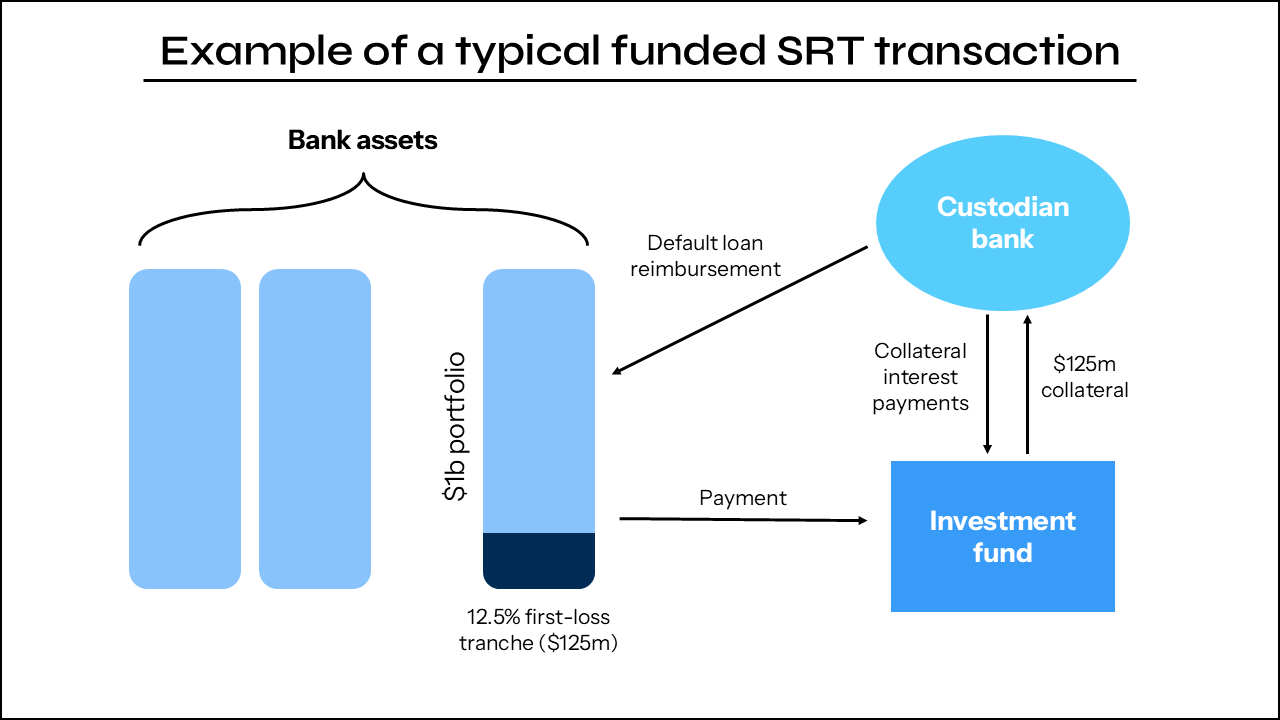Primer: Introduction to significant risk transfers
Significant risk transfer (SRT) transactions encompass a broad set of cash or synthetic securitizations that have proven to be valuable risk-management tools for banks to share credit risk with third-party investors, such as private credit funds and other private investors.(1) Specifically, an SRT transfers the credit risk related to a pool of assets a bank holds on its balance sheet to investors using a guarantee or credit derivative often supported by collateral or a credit-linked note (CLN). Banks choose to transfer credit risk for various reasons, such as default risk, or concentration risk in a given industry, geography, or loan type. Regardless of the reason to transfer credit risk, SRTs benefit banks by enabling them to reduce credit risk and originate new loans. SRTs also benefit investors by enabling them to diversify their portfolios and enhance returns.
Variations of SRTs are common in Europe and are increasingly being used in the United States. They can be a safe and efficient tool for banks to manage their credit risk, optimize capital deployment, and improve the banking system’s stability.
What are SRTs?
SRTs are a well-understood risk management tool banks have used since the 1990s to share a loan portfolio’s credit risk with third-party investors, such as insurance companies, pension funds, and alternative investment funds. In an SRT, a bank and third-party investor negotiate a contract in which they agree that the bank will pay investors a certain rate to bear a share of a loan portfolio’s credit risk. That share is generally the first-loss or junior slice of the entire loan portfolio. In exchange, the investor agrees to cover the loan portfolio’s losses up to a negotiated threshold. The threshold typically varies with the transaction and the jurisdiction. For example, the threshold for U.S. banks is the first 12.5% of losses, often referred to as the 0 to 12.5% tranche.
When a bank properly structures SRTs, prudential regulators permit the bank to claim capital relief for the loan pool whose credit risk it transfers to the investor. The bank can substitute the original risk weight of the loan pool with the lower risk weight required by the tranches it has not transferred to the investors.
An SRT covers default events that could occur in the loan portfolio, such as bankruptcy, failure to pay, and restructuring. When a loan in the portfolio suffers a default event, the bank must notify the investor by issuing a credit event. The protected tranche is written down by the amount of the realized loss, effectively transferring the loss to the investors. After a credit event and the realization of the loss, the bank continues to pay the investor based on the smaller notional balance.
Depending on the underlying asset, the time needed to determine a loan’s final loss can be months or, for certain assets, years. As a result, most SRT structures incorporate the concept of estimated loss. If the realized loss differs from the estimated loss, there is a so-called true up that can go in either direction (i.e., from the investor to the bank or the bank to the investor, depending on the difference between the realized loss and estimated loss).
For some types of assets, SRTs are structured with a replenishment period, meaning that for an agreed-upon period, the bank can add new loans to the portfolio as old loans mature.(2) Replenishment allows banks to transfer additional credit risk to investors subject to agreed-upon eligibility criteria, the most common of which is that the loan comes from the same wider portfolio and share the original loan’s credit characteristics (e.g., a maturing large balance corporate loan must be replaced by a large balance corporate loan with the same credit quality as the maturing loan). Banks can keep the same amount of loss protection as their loan book evolves during the replenishment period.

What are the different types of SRTs?
There are distinct types of SRT transactions. The first way to differentiate SRTs is between funded and unfunded transactions. In a funded SRT transaction, the investor places collateral equal to the maximum potential loss into an account at a custodian bank to ensure performance. That is, losses in a funded SRT are typically 100% collateralized.
In an unfunded SRT transaction, by contrast, an investor with a strong credit rating (e.g., an insurer or regulated bank) does not need to pledge collateral because the bank can rely on the investor’s high credit quality to guarantee performance. However, the capital benefit in an unfunded SRT is subject to a modest haircut to protect the bank against the risk of the investor’s potential default. The Federal National Mortgage Association (Fannie Mae) and Federal Home Loan Mortgage Corporation’s (Freddie Mac) credit risk transfer (CRT) programs allow for unfunded SRTs.
An alternative to funded and unfunded SRT transactions is for the bank to issue a CLN. A CLN involves issuing notes to investors for cash, where the principal due on the notes is reduced if the loan pool experiences losses. As a result, the investors who buy the note provide credit protection to the loan pool by paying cash for the note and having their principal reduced if the loan portfolio experiences losses.
Within CLNs, the distinction between CLNs issued by a Special Purpose Entity (SPE) and those a bank directly issues matters for regulatory purposes. In September 2023, the Federal Reserve offered guidance in the form of Frequently Asked Questions (FAQs) on how current regulations apply to the two types of CLN transactions.(3)
What are the Benefits of SRTs?
SRTs contribute to a more efficient financial system by enabling banks to deploy capital more effectively and make credit more widely available to customers. For banks, SRTs provide a powerful tool for transferring credit risk from their balance sheets to investors. Banks maintain their direct relationships with the borrowers, because SRTs only involve the transfer of first-lost credit risk to the investors, not the sale or transfer of loans to them.
For investors, SRTs offer an opportunity to earn returns by assuming credit risk associated with diversified portfolios of bank loans. SRTs diversify investor portfolios and provide them with exposure to credit markets without directly owning the underlying assets and having to service and manage them.
For regulators, SRTs can be beneficial because they remove risk from the banking system, which features a government backstop, and transfer it to investors willing to bear the loan portfolio’s credit risk. Regulators recognize the benefits of shifting the loan portfolio’s credit risk from the bank to capital markets by granting the bank undertaking the SRT transaction capital relief.
How are SRTs regulated?
SRTs are subject to robust regulation and internal bank controls to ensure their stability and transparency. The Federal Reserve’s September 2023 FAQs recognized that properly structured SPE CLNs and the collateral underlying them satisfy the criteria to serve as a credit risk mitigant for the bank.(4) On the other hand, existing regulations are more ambiguous for directly issued CLNs. The Federal Reserve considers each direct CLN transaction individually to determine whether it effectively transfers credit risk to third-party investors. More broadly, the Federal Reserve, the Office of the Comptroller of the Currency, and the Federal Deposit Insurance Corporation enforce strict requirements for capital adequacy, risk management, and transparency that banks must meet when engaging in SRT transactions.
Moreover, an SRT is more efficient and cost effective for the bank if it transfers relatively low risk assets with high risk-weighted asset requirements to the investors.(5) If a bank used an SRT to shift high-risk assets with large expected losses to an investor, the investor would charge a risk premium to bear the anticipated losses plus a return on capital, and the bank would only obtain a minimal amount of capital relief. As a result, the economics of SRT transactions are stronger if the underlying loan portfolio’s credit risk is low relative to its risk weighting.
References
1 SRTs include several types of transactions, such as synthetic risk transfers, credit risk transfers, and regulatory capital relief trades, that share common characteristics but differ in the details. For example, government-sponsored enterprises (GSEs) such as Fannie Mae and Freddie Mac use CRTs to shift part of their credit risk to third-party investors. CRTs have been successful in reducing the exposure of the GSEs to mortgage credit risk and creating a new market for pricing and trading that risk. See Finkelstein, D., Strzodka, A., Vickery, J. Credit Risk Transfer and De Facto GSE Reform (December 2018). Economic Policy Review, Vol. 24, No. 3, 2018. Available at: Credit Risk Transfer and De Facto GSE Reform.
2 Replenishments apply to commercial assets but not consumer assets.
5 For example, prime jumbo residential mortgage loans originated by large regional banks have low expected losses but require holding capital on 50% of the exposure. An SRT can reduce the risk weight to 20% at a relatively low cost.
